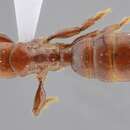en
names in breadcrumbs


[[ worker ]] Mandibulae elongato-triangulares supra convexae, infra concavae, margine masticatorio acuto non dentato, plus duplo longiori margine postico, margine externo arcuatim emarginato. Caput subquadratum, margine postico paulo arcuatim emarginato. Clypeus triangularis, angulo postico acuto inter antennarum articulationes interserto, margine antico paulo arcuato, disco longitrorsum convexo, transversim plano, carinulis duabus lateralibus, rectis, obtusissimis, indistinctis, longitudinalibus, postice versus convergentibus. Laminae frontales paulo incrassatae, subparallelae, extra arcuatae, intus inter se antice a clypei angulo postico acutissime producto, postice solummodo sulco frontali separatae. Antennae 12 articulatae; scapus paulo sigmoideo-curvatus, repositus ad capitis marginem posticum extensus; funiculus subfiliformis apicem versus paulo incrassatus. Oculi et ocelli nulli. Sulcus frontalis distinctus. Thorax inermis, sine strictura, suturis vero distinctis; pronotum convexum; mesonotum pronoto paulo brevius, semilunaris; metanotum praecipue antice lateraliter compressum, parte basali horizontali, parte declivi obliqua. Petiolus infra antice dente iustructus, supra cum nodo rotundato, lateraliter antice magis, postice minus, fortiter compresso, supra duplo longiori quam latiori, abdomini aequilato, postice ab abdominis basi separate. Abdomen inter segmentum primum et secundum constrictum. Femora extra ad basim arcuatim dilatata. Calcaria autica et postica lata et pectinata, media spiniformia. Tibiae mediae et tarsi posteriores fortiter spinulosa. Unguiculi simplices.
Diese neue Gattung ist mit Typhlomyrmex zunaechst verwandt und unterscheidet sich von dieser insbesondere durch den zwischen den Stirnleisten lang zugespitzten Clypeus (waehrend er bei Typhlomyrmex zwischen den Stirnleisten stumpfeckig endet), durch die mit vielen kurzen Stacheln versehenen Schienen und Tarsen der Mittelbeine und Tarsen der Hinterbeine, so wie durch die breiten messerfoermigen, am Innenrande schoen gekaemmten Sporne der Vorder- und Hintertibien (waehrend bei Typhlomyrmex die Tarsen nur behaart und die Sporne der Hintertibien sehr schmal dornfoermig sind).
Centromyrmex is a pantropical, though mainly Afrotropical, genus of ants in the subfamily Ponerinae. This ponerine ant was recorded for the first time in French Guiana and the most northerly point of recording was in Costa Rica. The specimens reported here were collected in a region of Amazon Forest with flight interception traps.
They are predatory on termites, where a group hunting strategy may be employed,[2] or may prey more generally on invertebrates in the upper soil layer of forests.[3] Little is known about their biology, but workers lack eyes and are well adapted to a subterranean lifestyle by way of burrowing. They also are equipped with short, spiny, and powerful legs. Nest sites are usually found near or even inside of termite nests. [3]
Centromyrmex is a pantropical, though mainly Afrotropical, genus of ants in the subfamily Ponerinae. This ponerine ant was recorded for the first time in French Guiana and the most northerly point of recording was in Costa Rica. The specimens reported here were collected in a region of Amazon Forest with flight interception traps.